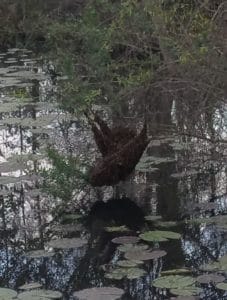A lot is happening in the apiary in early spring, so this month I’ll tell you about you three separate items:
First Item: Southern Swarm Season
 Early March is swarm season here in south Alabama, and swarms have been keeping me busy. The total from my home yard (6 colonies) so far has been 6 swarms, four of which I have caught and hived, and two were uncatchable. This month’s photo shows one of the uncatchable swarms; it is so close to the water in my pond that I couldn’t get any sort of a catch box under them. On land, this swarm would have been an easy catch, but over water, all I could do is wish those bees luck at finding a new home. After a day, they did take off for a new home, unfortunately for me, their new home wasn’t one of my bait hives. I can only hope those bees found a nice hollow tree and not the walls of someone’s house.
Early March is swarm season here in south Alabama, and swarms have been keeping me busy. The total from my home yard (6 colonies) so far has been 6 swarms, four of which I have caught and hived, and two were uncatchable. This month’s photo shows one of the uncatchable swarms; it is so close to the water in my pond that I couldn’t get any sort of a catch box under them. On land, this swarm would have been an easy catch, but over water, all I could do is wish those bees luck at finding a new home. After a day, they did take off for a new home, unfortunately for me, their new home wasn’t one of my bait hives. I can only hope those bees found a nice hollow tree and not the walls of someone’s house.
My attitude toward swarms has changed over the years. I was originally taught that swarm prevention worked, and if one of your colonies swarmed it was because you hadn’t been diligent in your swarm prevention measures. I still practice swarm prevention (reversing), but my observation has been that while you may delay swarming, you really can’t stop it. I now prefer my colonies swarm early and be done with it. While swarming does depopulate the parent colony, down here in south Alabama colonies that swarm in early March will have enough time to rebuild their populations before our main nectar flow begins in mid-April.
Swarming also has another benefit. As I am increasing my bee colony numbers, all of my caught swarms are being installed in my new hives.
Second Item: My Formic Acid Experience
I did a Varroa survey back in January and found the mite counts were disturbingly high. Having never used formic acid before, I decided to use Miteaway Quick Strips® (formic acid) as my midwinter treatment. The instructions call for putting two strips in a colony for 7 days; the third week in January had suitable daytime high temperatures predicted (about 65 F), so in went the strips. (Important Caveat: formic acid can cause chemical burns. If you use it, be sure to read and understand the instructions and follow all the safety protocols.)
I was quite impressed with the initial mite drop and was looking forward to my detailed hive inspections a month after my treatment. I thought I was on to something.
The detailed inspections a month after the treatment found the following:
- Mite counts were about 20% of what they were before treating. (good)
- No damage to plastic frames. (good)
- 3 out of the 10 treated colonies lost their queens. (bad)
Fortunately, all was not lost for those three colonies. While commercial queens are not available in mid-February, drones are locally available, so I put frames with eggs into the three queenless colonies to let them raise their own queens. Still, I had to scramble to get those hives back on track.
Third Item: “Bee Math”
Last month’s letter ended with a “bee math” problem for you to solve:
You observe a colony is queenless, but it does have sealed queen cells. You elect to let the bees requeen themselves. How long until you see a) eggs, and b) new adult bees from the new queen?
Here’s the solution (or range of solutions, to be more accurate):
You saw capped queen cells. Queen cells are capped for 7 days, and you have no way of telling on what day the queen cells you saw were capped. We’ll assume the cells you saw were just capped, so the queens will emerge 7 days later.
The new queen will need to be mated before she starts laying; that typically happens 7 days after she emerges. Egg laying starts 3 days after mating, giving 10 days from emergence to first eggs, or 17 days from our observing the queen cells to first eggs.
The eggs will become adult worker bees 21 days later, giving a total time of 38 days (call it 5 1/2 weeks) from observing the capped queen cells to the first adults from the new queen. Of course, if you saw queen cells that were about to emerge, the first worker bees would emerge a week sooner.
So what’s the point of this “bee math” problem? About a month will be needed for a colony to get adult progeny from a new queen. Most colonies raising a new queen will still have larvae in development from their old queen to compensate for the period when the new queen gets going, but still slipping a queenless colony a frame of brood from another colony will help smooth out the bee population during the transition period.
-Bill Miller
